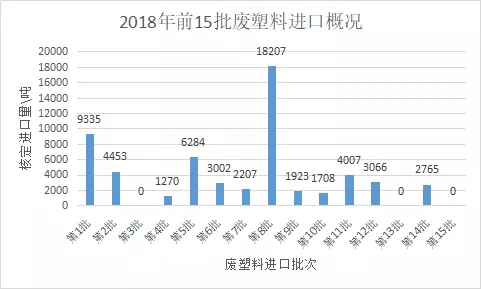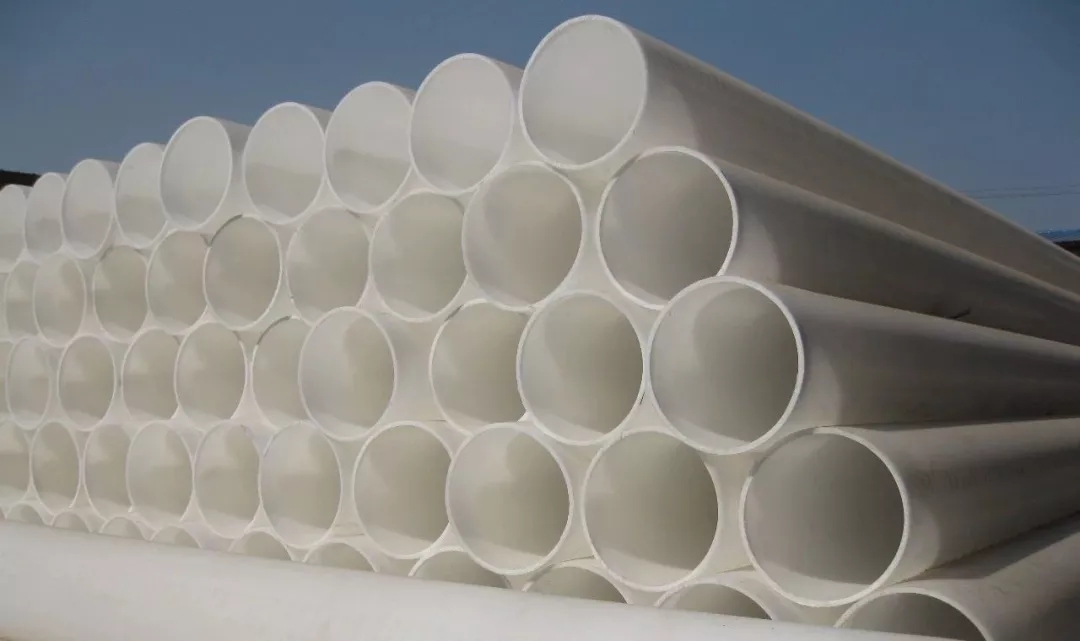Halfway through 2018, a total of 15 batches of waste were imported in the first half of the year, 12 of which contained waste plastics, totaling 58,227 tons, and the recently announced 15th batch of approvals did not have any waste plastics.

Compared with last year, a total of 11 batches of waste plastics were imported throughout 2017. As of May 2017, a total of 7,050,562 tons were imported.

In other words, this year's imports are less than 1% of last year's imports. Whether the waste plastics will continue to be imported in the next six months is still unknown, but everything will be closed on December 31, 2018.
Gao Chunyu, a senior expert at the Institute of Economics and Technology of Sinopec Group Company, said at a recent plastics industry conference that domestic imports of waste plastics have been largely eliminated, but products imported under the new material model are increasing.
1. Waste plastics imports have become history
The import of waste plastics began in the 1990s. The main reason is the rapid development of domestic plastic consumption, and domestic plastic production cannot meet the demand of consumption, so the import of waste plastics makes up for this shortage.
In the history of more than 20 years of import of waste plastics, the highest import year was in 2012, importing 8.87 million tons of waste plastics. In the next few years, the import of waste plastics showed a downward trend, and by 2017 the import volume was 7.05 million tons.

Whether domestic or foreign, the use of waste plastics is very extensive, PET is a very good raw material for chemical fiber, PE can be used in most packaging products, in addition to food packaging.
Therefore, after the domestic waste plastics import is basically completely stopped, there are still 40,000 tons of waste plastics processed in foreign countries imported into the country in the form of recycled granules.
Because the price of waste plastics is relatively low, many products in China need low-cost items. After the import of waste plastics has stopped, it has a great impact on the plastics market at home and abroad.
2. What changes have occurred in the global new material market after the import has stopped?
Taking polyolefins as an example, the changes in the global new material market are seen from the perspective of capacity, demand and consumption.
Polyethylene
In 2017, the global polyethylene production capacity increased by more than 6 million tons, of which the linear increase was the most, reaching more than 3 million tons, and the global production capacity has reached 110 million tons.
In 2017, global polyethylene demand has reached 92 million tons, an increase of 3.8%, and demand growth has maintained a very good level.
In PE consumption, film products are still the main driver of future growth. Due to the slowdown in the construction industry, the growth rate of pipe has declined. The consumption of film is still the main driver of consumption growth.

Polypropylene
In 2017, global polypropylene production capacity increased by 3.69 million tons, which is the lowest growth rate in the past three years. In 2015 and 2016, global polypropylene production capacity increased by more than 4 million tons. At present, the global polypropylene production capacity is close to 80 million tons.
Global polypropylene demand is 70 million tons, up 4% year-on-year. Like polypropylene and polyethylene, global demand growth has remained at a very good condition.
The consumption structure of drawing materials and films is increasing. Due to the slowdown in the growth of automobile production in foreign countries, especially in the United States and Europe, the global injection molding of polypropylene has declined.

3. Changes in China's polyolefin market after the import ceases
Polyethylene
In recent years, China's polyethylene production capacity has grown slowly. In 2017, China's new polyethylene production capacity was more than 1 million tons, the output was 16 million tons, the import was more than 12 million tons, and the apparent consumption was 28 million tons.
Demand for polyethylene increased by 11% in 2017 and has recently increased by 2.6 million tons. Therefore, at present, the growth rate of domestic polyethylene production capacity is far lower than the growth rate of domestic demand, and polyethylene still needs a large amount of imports.
This is why a large amount of polyethylene waste plastics have been imported domestically for many years, and the recycled particles of polyethylene still need to be imported in large quantities.

Polypropylene
In 2017, China's new polypropylene production capacity is about 800,000 tons. At the end of this year, the polypropylene production capacity is about 23.5 million tons, the output is 20.2 million tons per year, the import volume is 4.9 million tons, and the apparent consumption is 24.93 million tons. 10.4%.
From the analysis of the situation in 2017, the slowdown in the growth rate of polypropylene production capacity is the main reason for the current price of polyethylene and polypropylene.
4. Prospects for polyolefin prices in the second half of 2018
Future changes in polyolefin prices will be determined by oil prices, new capacity and consumer demand.
international market
It is estimated that oil prices are unlikely to rise very high in the next six months, most of which fluctuate between 65-75 US dollars, and the overall price is relatively stable.
From 2017 to 2018, the global new capacity of polyethylene continues to increase, especially in the United States. Beginning in 2018, the United States may become the main provider of polyethylene export growth, and each quarter's exports will be close to 3 million tons, while the previous range was between 2 million and 2.5 million tons.
As economic development drives the consumption of polyethylene and China's restrictions on the import of waste plastics, the market needs more new materials to supplement. In 2018, global polyethylene demand is close to 100 million tons, up 4.3% year-on-year. The fastest growth is still Linear low density polyethylene.

The growth of global polypropylene will be higher, which is reflected in the growth of the global economy, which will lead to the development of the industry. In particular, the growth of bulk raw materials will drive the growth of packaging materials, which may reach 4.7%, an increase of 0.7% over the growth in 2017. Percentage points.
Domestic market
In the first four months of 2018, domestic polyethylene production increased by 3.1%, imports increased by 4.58 million tons, up 15.3% year-on-year; while domestic production of polypropylene grew very fast, imports declined, and the supply of polypropylene slowed down significantly.
Due to the cancellation of waste plastics, the demand for waste plastics has not been involved in the replacement of waste plastics. It is estimated that the demand for polyethylene in China this year will be about 30 million tons, an increase of about 7%. About 2-3 percentage points will replace waste plastics. Similarly, polypropylene demand is expected to increase by 7.5% this year, and 2.5% is to replace used plastics.

In addition, the Sino-US trade war is an unresolved topic. As the current domestic polyethylene increase mainly comes from the United States, if the polyethylene cannot be imported smoothly from the United States, the shortage of value waste, the supply of domestic polyethylene may cause problems, but also Looking at the third quarter of this year, it is expected that the price difference between ethylene and propylene will remain relatively stable in the future, especially if the price of polypropylene will exceed that of polyethylene.
Pyrite as Fillers Used in Grinding Wheels/ Abrasive Tools
Ablation grinding wheel / abrasive( filling agent )
PYRITE__As fillers used in grinding wheels/ abrasive tools
Place of Origin: Henan Luoyang, China
Pyrite, Iron pyrites , pyrites lump, Ferro sulphur, Pyrites powder.
Product Description
Detailed introduction: s filling agent for ablating grinding wheel abrasive, which can effectively reduce the grinding wheel temperature during ablation, improve the heat resistance, and prolong the service life of the grinding wheel.
Formation of a protective layer
(1)The reaction absorbing oxygen occurs between 400 and 475 degrees, thereby reducing the oxidation of resin, reducing the oxidation burn of workpieces, and prolonging the working life of grinding wheels at high temperature.
4 FeS2 + 11 O2→2 Fe2O3 + 8 SO2
(2) 4 FeS + 7 O2→4 Fe2O3 + 4 SO2
400-475 degrees is a limit that the grinding wheel can easily reach. The above reaction creates an oxygen-free and hypoxic environment for the grinding wheel at the micro level, thereby improving the high-temperature performance of the grinding wheel.
Decomposition reaction occurs at 650-degree heat absorption, thereby reducing the working temperature of the grinding wheels.
FeS2→FeS + S
(3) It enters the melting state at about 1100 degrees, which becomes a good lubricant to protect the grinding wheel FeS(s)→FeS(l).
(4)Sulfur, sulfur dioxide and sulfur trioxide react with the workpiece surface to form FexSy:
Quality:
S: 48%min, FE: 42%min, SIO2: 3.0%max, PB: 0.1%max,
ZN: 0.1%max, AS: 0.1%max, . C: 0.3%max, CU: 0.2%max,
H20: 1.0%max, SIZE: 95%min
Granularity: (0-3)mm/(3-8)mm/(3-15)mm/(15-50)mm or other particle size.
Packing: 25KG/500KG/1000KG/BAG or 1000KG/BAG or other packaging.
Note: if there are special requirements, the product can be customized according to clients` requirements.
(In addition, our company is specialized in the production of `Hengkai Metallurgical" Brand - ferro sulphur series for foundry, copper removal agent series for lead smelting, debismuthizing agent for lead smelting, iron sulphide series for resin grinding wheel abrasive industry, iron sulphide series for brake pad friction industry, iron sulphide series for heavy metal wastewater treatment, iron disulphide series for soil improvement, iron disulphide for lithium battery anode, alloy sand series for wear-resisting flooring industry, ferrous sulphide powder series for ferrous sulphide cored wire, ferrous sulphide for ferrous sulphide cored wire, iron sulphide for resin grinding wheel, ferrous sulphide powder for heavy metal wastewater treatment, ferrous sulphide powder for soil improvement, ferrous sulphide cored wire, pyrite, ferrous sulphide ore, molybdenum oxide, high purity molybdenum trioxide, ammonium molybdate, titanium dioxide, cryolite powder, mullite, etc.)
Pyrite As Fillers Used In Grinding Wheels/ Abrasive Tools--HKYJ-LHT-SL
Abrasive Tools Pyrite
LUANCHUAN COUNTY HENGKAI METALLURGICAL MATERIALS SALES CO.,LTD , https://www.pyritechina.com
![<?echo $_SERVER['SERVER_NAME'];?>](/template/twentyseventeen/skin/images/header.jpg)